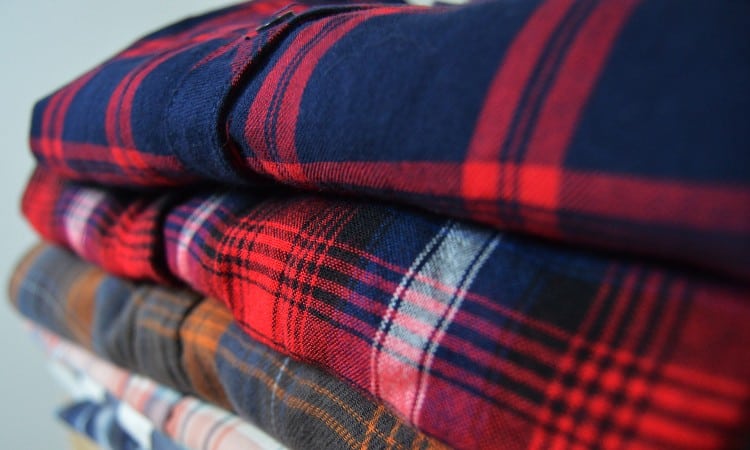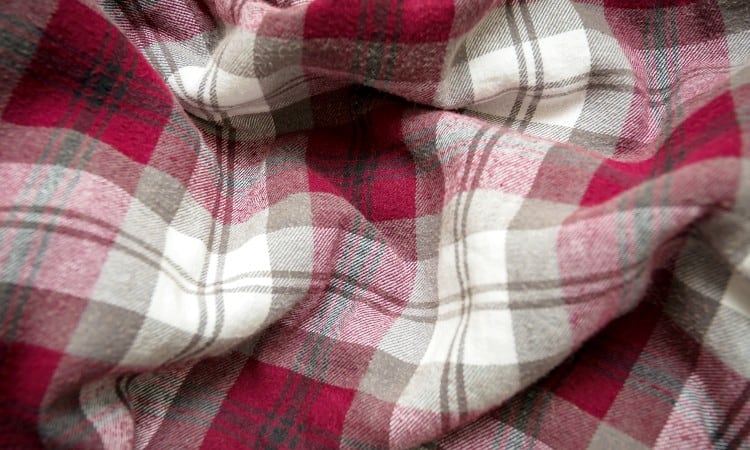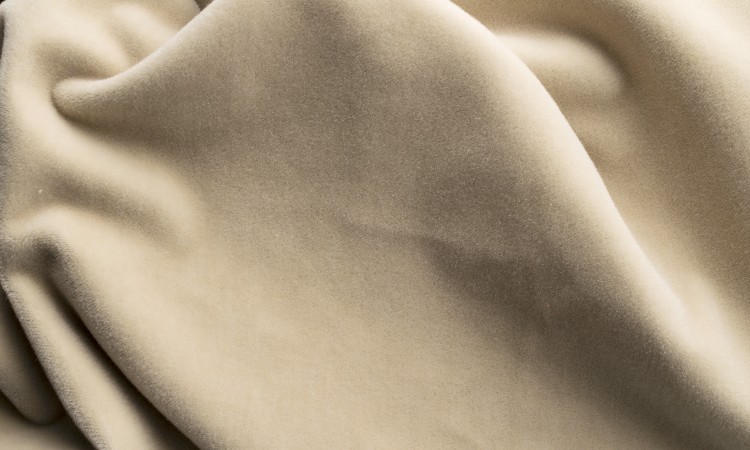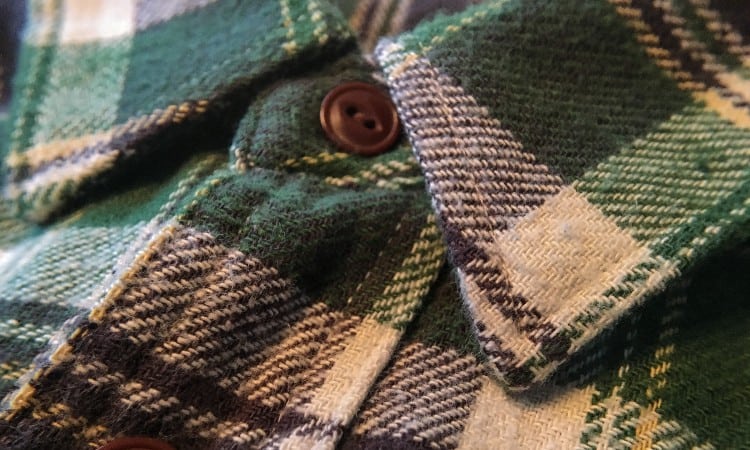I was out shopping for a birthday gift for my brother the other day and decided to get him some new button-down shirts. I quickly noticed that many stores had shirts made of flannel, while others labeled their options as chamois. That led me to wonder, what is the difference between flannel and chamois?
Chamois fabric was originally a leather product made from a species of goat-like antelope found throughout Europe. However, most modern chamois fabrics are made from cotton and are designed to replicate these original fabrics in thickness and softness. Flannel is a slightly thinner fabric woven from cotton, wool, or a blend of synthetic fibers.
Chamois and flannel make good clothing options but are still different in many ways. Keep reading and I’ll give you my full comparison of flannel vs. chamois and what to look for to tell the difference between these two fabrics.

Quick Navigation
Flannel vs. Chamois: Comparison Chart
We’ve created the chart below for you to use as a quick reference to understand the main differences between chamois and flannel fabrics.
| Flannel | Chamois | |
|---|---|---|
| Fiber Type | Traditionally wool, though cotton and synthetics have become popular replacements | Originally leather from goat-like antelopes; modern versions use cotton |
| Look and Feel | Often thinner than chamois; only brushed on one side | Typically thicker and softer than most flannel fabrics; brushed on both sides to give added softness |
| Patterns | Can come in any color or pattern, though most commonly is seen in plaid or checkered designs | Comes in a wide array of colors; typically offered as solid-color clothing instead of patterned |
| Weight | Varies; typically anywhere from medium to heavy-weight | Almost always medium-weight |
| Absorbency | Can be absorbent, depending on the fibers it is made of. Synthetics will be much less absorbent than natural fibers | Very absorbent |
| Price | Less expensive | More expensive |
| Care Instructions | Depends on the fibers that make it up. Cotton can be laundered as usual, but wool requires special care. Synthetic fibers are sensitive to heat. Air drying is likely required. | Cotton chamois can be washed and dried as you normally would your other clothing. Cotton can shrink in high temperatures. |
| Common Uses | Clothing; bedding; sleepwear | Clothing; fabrics to polish delicate surfaces; blending pigments on art projects |
What is Flannel?

You can recognize flannel because it is a soft, woven fabric commonly made from cotton, wool, or even a blend of natural and synthetic fibers. Flannel tends to be a medium-weight fabric, though some variation can lead to thicker or thinner versions being sold. It is typically brushed or “napped” on one side to give it a fuzzy appearance that helps the otherwise plain fabric to feel a bit softer.
Flannel is believed to have originated in the 17th century in Wales, where it was first woven out of wool. Over time, cotton and occasionally silk was added to the mixture; however, most modern flannel is made of cotton or a cotton-synthetic blend to give added comfort.
Cotton flannel today is a very widely used and affordable fabric, which you may see offered as a popular choice for clothing, pajamas, bed sheets, blankets, and other household goods. You may especially recognize flannel options for these products by spotting the distinct plaid patterns that flannel fabric is famous for having. Keep in mind, however, that flannel can come in virtually any color or pattern.
You’ll begin to see flannel popping up in stores as the winter months draw near. This is because the flannel is excellent at keeping you warm when the weather is cold. All-in-all, it’s an incredibly popular and cozy fabric to have around.
What is Chamois?

You may hear the name “chamois” referring to two different types of fabric, one of which is an imitation of the other. The first type is the original, leather-based fabric that originated in Europe in the 1700s. This fabric is produced from the hides of a goat-like antelope known as a Chamois, mostly found high up in the Pyrenees mountains.
Chamois leather was originally used throughout Europe and eventually New Zealand for making soft and thick gloves and other everyday clothing. It was also widely used in making cloth for polishing and cleaning since its softness helps prevent scratching on delicate surfaces.
Eventually, fabric manufacturers began trying to replicate chamois leather using cheaper products that were easier to produce. They turned to cotton and began making what we now know as modern chamois. Most of the chamois fabric you’ll find on the market today is this cotton chamois, not the true leather version that came before it.
In this article, we will be discussing cotton chamois primarily. Leather chamois is not widely used outside of a few types of gloves or cleaning cloths. If you’re shopping for clothing, cotton chamois is what you’re likely to see.
Cotton chamois fabric is incredibly similar to cotton flannel fabric, both in look and feel. The primary differences are noticeable if you compare the thickness and softness of the two fabrics. Chamois is in many ways a more luxurious fabric to work with than many simple flannels available for purchase today.
Is Chamois the Same as Flannel?
At a glance, you might think that cotton chamois and flannel seem like they are the same fabric. After all, they are typically both medium-weight, have similar fluffy surfaces, and are comfortable and warm to wear. It’s no wonder then that people often get these two fabrics confused!
However, there are some subtle differences you can learn to recognize. Chamois and flannel are often made of entirely different fibers, ranging from natural options to synthetic ones. They also have different levels of softness and thickness.
Chamois tends to be heavier in feel, more durable, and generally a more luxurious type of fabric than many of the flannels you’ll see for sale.
Nevertheless, their names are often mixed up because cotton chamois and flannel can appear very similar. It’s easy to get confused, especially when many manufacturers mislabel their products as chamois when they are made of flannel, and vice versa. This only adds to the mix-up, and many customers may find themselves buying the wrong product by mistake.
What is the Difference Between Flannel and Chamois?

While, at first glance, flannel and chamois may appear similar, there are several subtle differences between the two. We recommend paying special attention to the fibers that make them up and the thickness and softness of the fabric itself.
Fiber Type
Flannel fabric was traditionally woven from wool produced in Wales. Over the years, flannel production has expanded to sometimes include cotton and synthetic fibers in its makeup. Much of the flannel found today is made from cotton or a blend of these fibers.
Chamois, by comparison, was originally made from leather taken from the hides of the European goat-like antelope that shares the same name. Over the years, more affordable and easier-to-produce cotton alternatives were created. Today, most of the chamois you find at the store will be made of cotton.
Fiber type is one of the reasons why flannel and chamois are often confused with one another. That is because they do share a fiber in common with one another – cotton. 100% cotton flannel and 100% cotton chamois are the most difficult to tell apart, so you may need to use the other differences listed below to determine these cases.
Look and Feel
Flannel fabric is relatively thin and medium weight, though this can vary from fabric to fabric. One side of the fabric is typically much softer, which may be slightly rough to the touch. This is because one side of the fabric is traditionally brushed or “napped” to give it a softer texture.
Chamois is often thicker than flannel fabric and softer to the touch. The more substantial feel to chamois comes from its tighter weave, which also helps make it more durable than flannel. This fabric is also soft all around since it is brushed on both sides of the fabric.
The brushing detail is one of the easiest ways to tell flannel and chamois apart when you compare them side-by-side. The process of brushing fabric uses fine-toothed metal brushes to raise the fibers of the fabric. This gives it an overall fluffy or fuzzy feeling, making the fabric soft to the touch. Chamois is brushed on both sides, flannel on only one.
Pattern
Both flannel and chamois fabrics can come in virtually any color or pattern imaginable. This is especially true for varieties made of natural fibers like cotton or wool in the case of flannel. However, there are some common patterns seen in flannel shirts that you’re far less likely to see in chamois.
Flannel shirts are known for the distinct plaid or checkered patterns they are often woven into. Plaid emerged in Scotland around the time that flannel first did in neighboring Wales in the 1700s, and the two have been inseparable ever since. Originally, plaid designs varied from region to region based on dyes and materials available, though much of the meaning behind plaid designs has been lost over time.
Nevertheless, today most flannel shirts will come in plaid designs. Bold red and black designs are particularly popular, especially around the holidays and winter months. You can still find other patterns or even solid-colored options if plaid isn’t your thing, but they’re much less common.
Chamois, by comparison, is found most often as solid-color fabric. It, too, can come in different designs and patterns, but not as often. This can be a good hint to whether you’re looking at flannel or chamois when comparing shirts at the store.
Weight
Flannel fabrics can vary in weight tremendously, usually due to the different combinations of fibers that can make them up. Cotton flannels, for example, are generally light and weigh around 5 ounces per square yard. On the other hand, wool flannels are much heavier and can weigh between 10-20 ounces per square yard.
Chamois fabric is almost always mediumweight. Cotton chamois tends to weigh around 8 ounces per square yard. It tends to have a more robust feel than most cotton flannels due to its tighter weave and this added weight.
Absorbency
Flannel fabrics can sometimes be absorbent, depending on the fibers that make them up. Cotton and wool will absorb moisture very well – wool especially so. Synthetic fibers, on the other hand, repel moisture and won’t absorb it at all.
Since modern chamois is made of cotton, it will absorb moisture well. Because it is typically made out of 100% cotton, most chamois will be more absorbent than many of the flannels on the market. This is simply due to many flannels having water-repelling synthetics added into their weave.
Price
On the whole, chamois is a more expensive fabric than flannel. It has a tighter weave, heavier feel, and is brushed on both sides of the fabric. In other words, its production requires more supplies, time, and skill to make – increasing its price.
Even then, prices can differ from fabric to fabric. Certain types of wool can get very expensive, which would almost certainly increase the cost to purchase flannels made from them.
However, if you’re comparing 100% cotton flannel directly to 100% cotton chamois, the chamois will almost always be more expensive. The quality is worth it, however, since these fabrics are more durable and long-lasting than most flannels.
Care Instructions
When it comes to flannel, it again depends on the fibers that make it up. Cotton can be washed however you normally would wash your clothes. It can tend to shrink in hot water or a dryer, so cold temperatures and water may be needed to prevent that.
However, wool and synthetic fibers require a bit more care. Washing wool fibers can be done in a washing machine, but only if you do so carefully and try to avoid agitating the cloth more than necessary. Wool fibers should never be dried in a dryer, however.
Synthetics also cannot handle excessive heat. They should only be washed in cold water and should be air dried as well. Unfortunately, there are no take-backs when it comes to washing synthetics and any damage that happens will most likely be permanent.
Chamois, by comparison, is fairly easy to care for. Cotton chamois can be washed however you normally would wash your clothes. It can be dried, though the heat can cause shrinking, so precautions will need to be taken if you don’t want this to happen.
Common Uses
Flannel fabric is mostly used for clothing and bedding in your home. It’s common to see flannel used to make shirts, pajamas, bed sheets, and blankets. Flannel is a popular choice for children’s products and nursery decor since it is soft and gentle.
Chamois is commonly used for clothing, especially men’s clothes. However, chamois fabric is also often used to make cloths to buff delicate surfaces. Its soft surface won’t leave micro-scratches on surfaces like many other fabrics will do.
Many artists also use chamois cloths to blend pigments on their art pieces since it is gentle enough to rub on canvases or artist’s paper.
Is Chamois Warmer Than Flannel?
Most cotton chamois fabrics are warmer than cotton flannel fabrics. They are thicker and have a tighter weave, making it difficult for cold air to pass through the cloth. Both sides of the chamois fabric are brushed, preventing air from flowing through to reach your skin.
Flannel fabrics generally have a looser weave, making them less warm than chamois. However, flannel fabrics are still generally a good option for cold weather. Wool flannels, in particular, will be very warm since wool fibers are naturally shaped to trap warm air against your body.
The least warm option for these fabrics would be a thin cotton flannel. While still somewhat warm, they won’t have the thickness of chamois or the heat retention of wool. If you’re looking for warmth, try sticking to one of the other options we’ve just discussed.
Is Chamois the Same Thing as Moleskin?
We’ve already discussed how chamois and flannel are often confused for one another. But chamois is also often confused for another popular fabric – moleskin. Chamois and moleskin are not the same and have some subtle differences.
Moleskin is a heavy cotton fabric that is densely woven. Some varieties are even woven tightly enough that they become windproof. This also makes it a very warm fabric, just like chamois tend to be.
However, there are some subtle differences that can be hard to see at a glance. Moleskin is sheared on one side, meaning that the threads have been cut. These threads stand upright, giving the fabric a soft pile on one side.
Chamois, by comparison, is brushed on both sides of the fabric. However, moleskin does still have a very similar feel to chamois regardless. It is also often described as being a suede-like or velvet-like fabric.
On the whole, chamois is a much more popular fabric for clothing than moleskin. If you’re looking at clothes in your favorite store and are unsure which material it is, chances are you are looking at chamois. When in doubt, ask the store or check the manufacturer’s labels.
Conclusion
Like many people on the quest for comfortable clothes to buy, I also wondered what the differences were between flannel and chamois. Fortunately, the differences are apparent once you take a closer look. After reading this article, you should be able to tell the difference between these popular fabrics if you ever come across them.